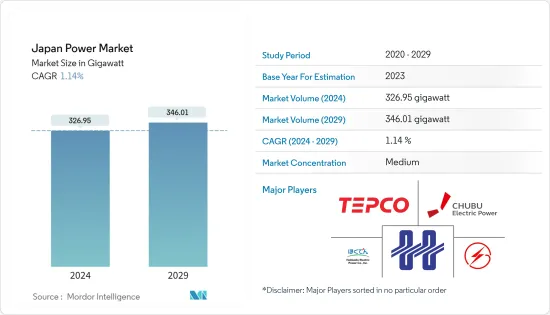Need help finding what you are looking for?
Contact Us
PUBLISHER: Mordor Intelligence | PRODUCT CODE: 1436067

PUBLISHER: Mordor Intelligence | PRODUCT CODE: 1436067
Japan Power - Market Share Analysis, Industry Trends & Statistics, Growth Forecasts (2024 - 2029)
PUBLISHED:
PAGES: 90 Pages
DELIVERY TIME: 2-3 business days
SELECT AN OPTION
The Japan Power Market size is estimated at 326.95 gigawatt in 2024, and is expected to reach 346.01 gigawatt by 2029, growing at a CAGR of 1.14% during the forecast period (2024-2029).

The market was negatively impacted by COVID-19. Presently the market has now reached pre-pandemic levels.
Key Highlights
- Over the medium period, the growth in renewable energy projects is expected to drive the Japanese power market.
- On the other hand, the relatively stagnant electricity demand is expected to hinder market growth during the forecast period.
- New and efficient technologies like supercritical and ultra-supercritical coal power plants, which reduce the amount of pollution (per KW), are expected to replace the aging power plants and will likely create several opportunities for the Japanese power market in the future.
Japan Power Market Trends
Thermal Power Generating Source is Expected to Dominate the Market
- Thermal power plants in Japan are mostly powered by natural gas. The country is the largest importer of liquefied natural gas (LNG) after China and uses a major portion of the LNG to produce electricity. In 2021, the country imported 101.3 billion cubic meters (bcm) of the total imported LNG in the world, which is approximately 19.6% of the LNG imported.
- After the 2011 tsunami, Japan had to close down most of its nuclear power plants, which made Japan use natural gas as a significant source of energy generation to fill the void. In the past decade, natural gas has emerged as a significant source of energy in the country.
- The Japanese thermal power sector is dominated by LNG-fired plants, which account for nearly 49.5% of the total power capacity. According to the Ministry of Economy, Trade, and Industry (METI) statistics, as of 2021, Japan has 69 plants with an average installed capacity of 1.1 GW. This is followed by coal-fired power plants, which account for nearly 95 plants and 32.2% of the total installed capacity.
- However, since the pandemic has subsided and demand has recovered, and the Russia-Ukraine conflict continues to have economic effects, global energy prices have spiked rapidly. This has created a huge demand spike in Japan, which has been dealing with high energy prices, as a result of which the country has been shifting to coal and natural gas to maintain energy security.
Growth in Renewable Energy Market is Likely to Drive the Market
- Japan is one of the countries leading the development of the renewable energy sector to reduce its dependency upon imported fossil fuels. Solar is one of the leading segments that has contributed significantly to renewable energy growth in Japan. In 2021, solar energy had an installed capacity of around 74.19 GW.
- The solar energy market in Japan is poised for growth in the coming years on account of the government's policy to implement clean energy measures in the country, the declining cost of solar energy generation, and reduced energy storage prices.
- The country has several renewable energy projects that are likely to replace old thermal power plants. Moreover, the adoption of renewable technologies is expected to reduce the country's expenses on imported fuel, thus saving its revenue for other developmental work.
- Yatsubo Solar Power Plant, Ikeda Solar Power Plant, and Miyagi Osato Solar Park are a few upcoming prominent projects that are likely to expand the country's renewable sector.
Japan Power Industry Overview
The Japan power market is moderately fragmented. The key players in the market (not in a particular order) include Hokkaido Electric Power Company, Tohoku Electric Power Company, Tokyo Electric Power Company, Chubu Electric Power Company, and Hokuriku Electric Power Company, among others.
Additional Benefits:
- The market estimate (ME) sheet in Excel format
- 3 months of analyst support
Product Code: 72379
TABLE OF CONTENTS
1 INTRODUCTION
- 1.1 Scope of the Study
- 1.2 Market Definition
- 1.3 Study Assumptions
2 EXECUTIVE SUMMARY
3 RESEARCH METHODOLOGY
4 MARKET OVERVIEW
- 4.1 Introduction
- 4.2 Installed Power Generation Capacity and Forecast in GW, till 2028
- 4.3 Electricity Generation and Forecast in TWh, Global, till 2028
- 4.4 Renewable Energy Mix, Japan, 2021
- 4.5 Recent Trends and Developments
- 4.6 Government Policies and Regulations
- 4.7 Market Dynamics
- 4.7.1 Drivers
- 4.7.2 Restraints
- 4.8 Supply Chain Analysis
- 4.9 PESTLE Analysis
5 MARKET SEGMENTATION
- 5.1 Power Generation Source
- 5.1.1 Thermal
- 5.1.2 Hydroelectric
- 5.1.3 Nuclear
- 5.1.4 Renewable
- 5.2 Power Transmission and Distribution (T&D)
6 COMPETITIVE LANDSCAPE
- 6.1 Mergers and Acquisitions, Joint Ventures, Collaborations, and Agreements
- 6.2 Strategies Adopted by Leading Players
- 6.3 Company Profiles
- 6.3.1 Hokkaido Electric Power Company
- 6.3.2 Tohoku Electric Power Company
- 6.3.3 Tokyo Electric Power Company
- 6.3.4 Chubu Electric Power Company
- 6.3.5 Hokuriku Electric Power Company
- 6.3.6 Kansai Electric Power Company
- 6.3.7 Chugoku Electric Power Company
- 6.3.8 Shikoku Electric Power Company
- 6.3.9 Kyushu Electric Power Company
- 6.3.10 Okinawa Electric Power Company
7 MARKET OPPORTUNITIES AND FUTURE TRENDS
Have a question?


SELECT AN OPTION
Have a question?


Questions? Please give us a call or visit the contact form.
